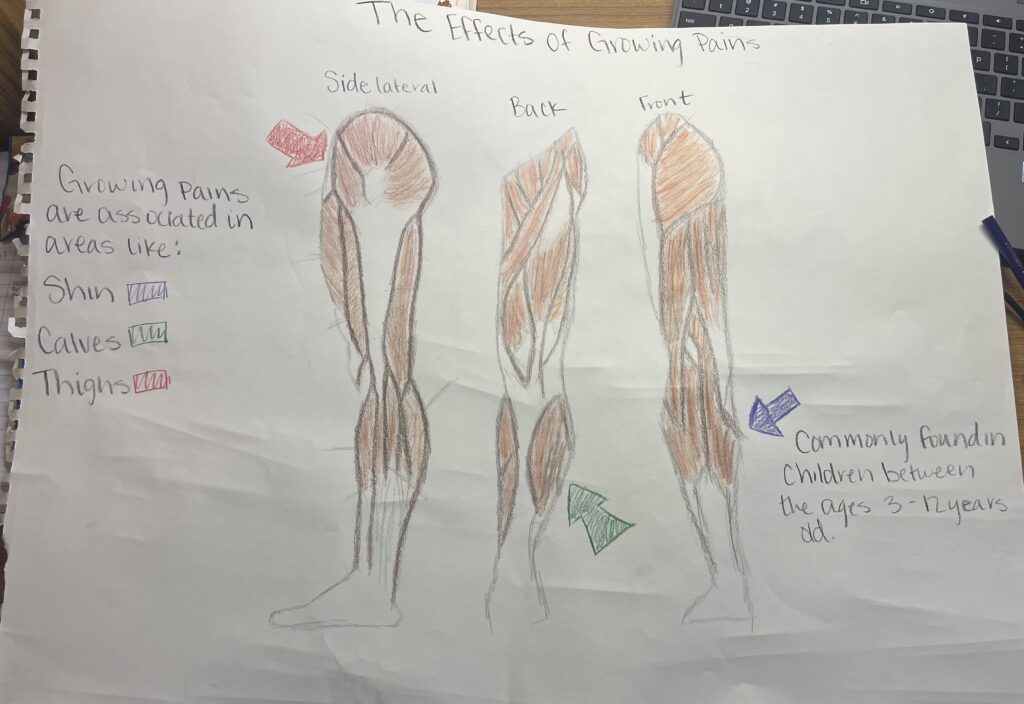I am covering the objective of how the interactions of muscles with the skeletal systems relate. I am also going to explain the physical effects on the child. My medium is a leg muscle. The leg muscles will demonstrate as a location director of where the child feels most pain.
Growing pain in children is a non-inflammatory episodic musculoskeletal pain syndrome (Uziel & Hashkes, 2007). Pain can be experienced with no signs of inflammation or damage to the area in question (Growing Pains – Better health channel, 2018). Growing pains are commonly found in children between the ages of 3-12 years old. My research suggests that there is no exact understanding as to why there are growing pains. It is experienced after activity. Symptoms of growing pains are main apparent in the evening or throughout the night. Pain is associated with areas like the shin, calves, and thighs.
It is suggested that hyperactivity is the leading cause of growing pains (Uziel & Hashkes, 2007). Another factor may be that there is a low bone density. Myofibrils break apart creating an unequal force with the separation of the Z-band and SR and T-tubule structure (Muscle Growth and Exercise, 2022). This may be a result of pain in sensitive to growing pain areas or low bone density. Resting overused muscles will give the muscle a chance to repair and create more fiber endings for growth.
Children with a low pain threshold are more likely to experience growing pains. Children with a lower pain threshold are likely to feel pain at pressures that are lower than those with a higher pain threshold. It is easier for lower threshold pain to experience pain on a hyperactivity basis. Common symptoms may be from 10 mins to several hours at a time of each episode that may occur weekly. Growing pains may happen weekly for active children.
Parents are most likely to predict when an episode may take place based on small characteristics that are the starting symptoms of growing pains (Uziel & Hashkes, 2007). These symptoms may include mood, activity level, and fatigue. Children that are more flexible and have flat feet are more susceptible to experiencing growing pains (Growing Pains in Kids: Causes & Symptoms, 2021). The lack of foot arch and muscle strength may lead to muscle fatigue without a strong structure holding it up. Low vitamin D levels are another contributor to having experienced growing pains. Vitamin D promotes skeletal muscle regeneration. Children with a vitamin d deficiency are likely to have trouble rejuvenating their muscle tissues and fibers.
Take your child to the doctor if pain worsens or happens more than once a week. Treatment for growing pains is usually resolved with pain relievers which help with the pain within 30 minutes. Doctors may suggest that rubbing and massaging the affected area may help with pain and resolve it in a more healthy way than taking NSAIDs (Growing Pains – Better Health Channel, 2018). Growing pains are not inflammatory muscle pain. So it does not get the muscles swollen. Vitamin D supplements may be good to give your child which can help them restore and help their muscle fibers and tissue thrive.

References
Uziel, Y., & Hashkes, P. J. (2007). Growing pains in children. Pediatric Rheumatology, 5(1). https://doi.org/10.1186/1546-0096-5-5
Muscle growth and exercise. (2022). Critical Reviews in Food Science & Nutrition. https://www.tandfonline.com/doi/abs/10.1080/10408399009527522
Growing Pains in Kids: Causes & Symptoms. (2021). Cleveland Clinic. https://my.clevelandclinic.org/health/diseases/13019-growing-pains
Growing pains – Better Health Channel. (2018). Vic.gov.au. https://www.betterhealth.vic.gov.au/health/healthyliving/growing-pains
